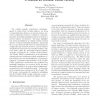Free Online Productivity Tools
i2Speak
i2Symbol
i2OCR
iTex2Img
iWeb2Print
iWeb2Shot
i2Type
iPdf2Split
iPdf2Merge
i2Bopomofo
i2Arabic
i2Style
i2Image
i2PDF
iLatex2Rtf
Sci2ools
FPL
1998
Springer
1998
Springer
Self Modifying Circuitry - A Platform for Tractable Virtual Circuitry
The readily available performance advantages, gained in early virtual circuitry systems, are being recouped following advances in general purpose processor architectures and have resulted in a questioning of the tractability of applying virtual circuitry in a general software environment. This paper highlights two primary limitations of existing virtual circuitry systems: technical bandwidth limitations, imposed by the use of a shared peripheral bus to interconnect the ble logic and host processor; and the abstract complications involved in traversing the hardware software divide within the inherently hardware software co-design environment of a virtual circuitry system. The Flexible URISC is introduced as an array resident minimal processor architecture with the potential to exploit self-reference and self-modi cation. Performance results of a prototype implementation of the Flexible URISC architecture demonstrate how peripheral bus bandwidth limitations are overcome by the increased...
| Added | 05 Aug 2010 |
| Updated | 05 Aug 2010 |
| Type | Conference |
| Year | 1998 |
| Where | FPL |
| Authors | Adam Donlin |
Comments (0)

